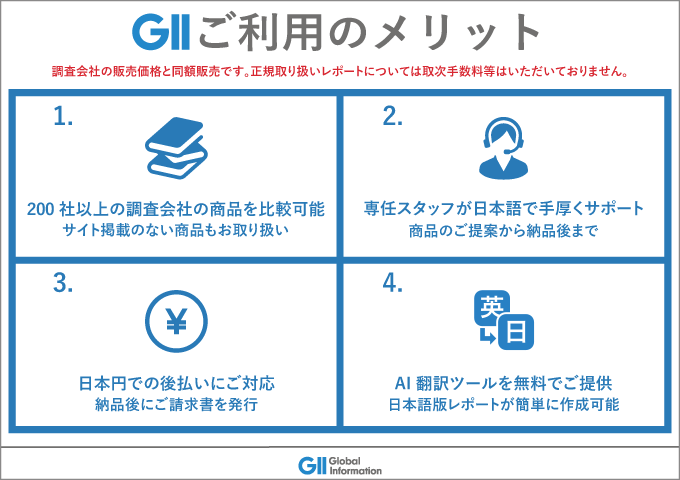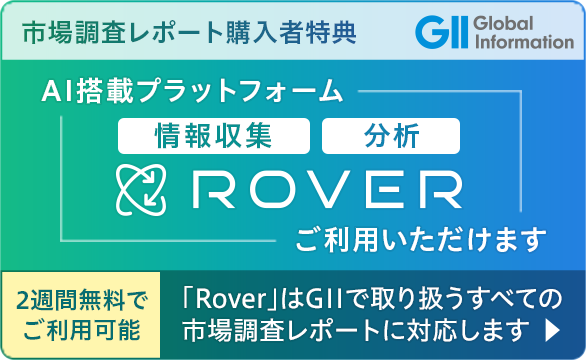|
|
市場調査レポート
商品コード
1289772
抗体薬物複合体の世界市場-2023-2030Global Antibody Drug Conjugates Market - 2023-2030 |
||||||
|
● お客様のご希望に応じて、既存データの加工や未掲載情報(例:国別セグメント)の追加などの対応が可能です。 詳細はお問い合わせください。 |
|||||||
| 抗体薬物複合体の世界市場-2023-2030 |
|
出版日: 2023年06月12日
発行: DataM Intelligence
ページ情報: 英文 195 Pages
納期: 即日から翌営業日
|
- 全表示
- 概要
- 目次
市場概要
抗体薬物複合体の世界市場規模は、2022年に50億3,280万米ドルに達し、2030年には165億9,460万米ドルに達し、有利な成長が予測されます。予測期間中(2023年~2030年)のCAGRは16.6%となっています。
世界の抗体薬物複合体市場は、がんの有病率の増加、がんに関する研究開発への投資の増加、がんに対する革新的な標的治療法の増加、抗体工学および複合化技術の進歩などの要因によって牽引されています。
市場力学
がんの有病率の増加
がんの有病率の増加は、予測期間中の市場シェアを押し上げる主要因です。世界的にがんの発生率が増加しているため、効果的な治療法を必要とする患者数が増加しています。ADCは、細胞毒性ペイロードをがん細胞に直接投与することで、がん治療への標的アプローチを提供し、治療成績を向上させる可能性があります。がん患者数の増加に伴い、ADCのような革新的で効果的な治療法への需要が高まっています。
化学療法、放射線療法、手術などの従来のがん治療には、有効性や忍容性の面で限界があります。ADCは、モノクローナル抗体の特異性と化学療法剤の細胞毒性作用を組み合わせることで、より高い効果を発揮することができるようになりました。ADCは、モノクローナル抗体の特異性と化学療法剤の細胞毒性との組み合わせにより、がん細胞を選択的に標的とし、健康な細胞を温存することができるため、治療成績の向上につながります。がんの増加により、より効果的な治療法の開発と導入が必要とされており、ADCは有望なソリューションとして位置づけられています。
ADCの製造コストと副作用の高さ
抗体薬物複合体に関連する高い製造コストと副作用は、予測期間中の市場シェアを妨げる主要因です。ADCの開発および製造には、モノクローナル抗体の製造、コンジュゲーション化学、精製、製剤化など、複雑な工程が含まれます。これらのプロセスには、専門的なインフラ、専門知識、リソースが必要であり、その結果、製造コストが高くなります。
ADCの製造コストが高いため、特に予算が限られているヘルスケアシステムや資源が限られている地域では、ADCへのアクセスや購入のしやすさが制限されることがあります。また、ADCのコストは、ヘルスケア支払者による償還の障壁となり、市場シェアにさらに影響を与える可能性があります。
ADCは、細胞傷害性薬剤をがん細胞に選択的に送達するように設計されていますが、それでもオフターゲット効果や副作用を引き起こすことがあります。一般的な副作用には、血液毒性、肝臓毒性、免疫原性、輸液関連反応などがあります。副作用や安全性の懸念は、患者さんの受け入れ、治療のコンプライアンス、ADCの市場導入に影響を与えるため、副作用を軽減し、安全性プロファイルを高めることが重要です。
COVID-19の影響分析
COVID-19のパンデミックは、抗体薬物複合体市場に大きな影響を与えました。パンデミックによる世界のサプライチェーンの混乱は、ADCの生産と入手に影響を及ぼしました。ロックダウン、渡航制限、検疫措置により物流や輸送が混乱し、原材料、試薬、最終製品の遅延や不足が発生しました。サプライチェーンの混乱は、ADCの製造能力、在庫レベル、納期などに影響を及ぼしています。
また、パンデミックはADCの臨床試験の遅延や中断につながりました。ヘルスケアシステム、臨床試験依頼者、規制当局の焦点はパンデミックへの対応に移っており、進行中の臨床試験の遅延や中断に繋がっています。臨床試験の遅れは、薬事承認スケジュールやADCの市場参入に影響を与える可能性があります。
ロシア・ウクライナ紛争分析
ロシア・ウクライナ紛争は、抗体薬物複合体市場にマイナスの影響を与えました。紛争が拡大し、政情不安に陥った場合、ADCを含む医薬品の世界サプライチェーンが混乱する可能性があります。ウクライナは医薬品原料の生産において重要な役割を担っており、強固な医薬品産業を有しています。
輸出規制、輸送の途絶、政情不安などサプライチェーンに混乱が生じた場合、ADCの生産に必要な原材料や成分の入手に影響を与え、供給不足に陥り、市場に影響を与える可能性があります。
国際的ながん臨床試験には、ウクライナとロシアが大きく貢献しています。ウクライナの状況は、臨床試験の実施に様々な影響を与えますが、主に治療施設の閉鎖、国内避難民、強制移住に影響を与えます。
目次
第1章 調査手法とスコープ
- 調査手法
- 調査目的および調査範囲
第2章 定義と概要
第3章 エグゼクティブサマリー
第4章 市場力学
- 影響要因
- 促進要因
- がんの有病率の増加
- 抑制要因
- 高い製造コストとADCの副作用
- 機会
- 影響分析
- 促進要因
第5章 産業分析
- ポーターの5フォース分析
- サプライチェーン分析
- 価格分析
- 法規制の分析
第6章 COVID-19の分析
第7章 アプリケーション別
- 乳がん
- 血液がん
- 皮膚がん
- 肺がん
- 卵巣がん
- その他
第8章 技術別
- 切断可能リンカー
- 開裂不可能リンカー
- リンカーレス
第9章 地域別
- 北米
- 米国
- カナダ
- メキシコ
- 欧州
- ドイツ
- 英国
- フランス
- イタリア
- スペイン
- その他欧州
- 南米
- ブラジル
- アルゼンチン
- その他南米地域
- アジア太平洋地域
- 中国
- インド
- 日本
- オーストラリア
- その他アジア太平洋地域
- 中東・アフリカ地域
第10章 競合情勢
- 競合シナリオ
- 市況/シェア分析
- M&A(合併・買収)分析
第11章 企業プロファイル
- Takeda Pharmaceutical Company Ltd.
- 会社概要
- 製品ポートフォリオと説明
- 財務概要
- 主な発展状況
- Hoffmann-La Roche Ltd.
- Pfizer Inc.
- AstraZeneca
- Gilead Sciences Inc.
- Seagen Inc.
- Astellas Pharma
- Daiichi Sankyo Company Ltd.
- GlaxoSmithKline Plc
- ADC Therapeutics
第12章 付録
Market Overview
The Global Antibody Drug Conjugates Market size reached US$ 5,032.8 million in 2022 and is projected to witness lucrative growth by reaching up to US$ 16,594.6 million by 2030. The market is exhibiting at a CAGR of 16.6% during the forecast period (2023-2030).
The global antibody drug conjugates market is driven by factors such as the increasing prevalence of cancer, growing investments in research and developments related to cancer, increasing innovative and targeted treatment options for cancer, and advancements in antibody engineering and conjugation technologies.
Market Dynamics
Increasing Prevalence Of Cancer
The increasing prevalence of cancer is a major factor driving the market share during the forecast period. The increasing incidence of cancer globally has resulted in a larger patient population in need of effective treatments. ADCs offer a targeted approach to cancer therapy by delivering cytotoxic payloads directly to cancer cells, potentially improving treatment outcomes. As the number of cancer patients rises, there is a greater demand for innovative and effective therapies like ADCs.
Traditional cancer treatments, such as chemotherapy, radiation therapy, and surgery, have limitations in terms of efficacy and tolerability. ADCs have demonstrated enhanced efficacy by combining the specificity of monoclonal antibodies with the cytotoxic effects of chemotherapy drugs. They can selectively target cancer cells while sparing healthy cells, leading to improved treatment outcomes. The increasing prevalence of cancer necessitates the development and adoption of more effective treatments, positioning ADCs as a promising solution.
High Production Cost & Side Effects of ADCs
High production costs and side effects associated with antibody drug conjugations is a major factor hampering the market share during the forecast period. The development and manufacturing of ADCs involve complex processes, including the production of monoclonal antibodies, conjugation chemistry, purification, and formulation. These processes require specialized infrastructure, expertise, and resources, resulting in high production costs.
The high cost of producing ADCs can limit their accessibility and affordability, especially in healthcare systems with budget constraints or regions with limited resources. The cost of ADCs can also be a barrier to reimbursement by healthcare payers, further impacting market share.
ADCs are designed to deliver cytotoxic agents selectively to cancer cells, but they can still cause off-target effects and side effects. Common side effects include hematological toxicity, liver toxicity, immunogenicity, and infusion-related reactions. Side effects and safety concerns can impact patient acceptance, treatment compliance, and market adoption of ADCs, so it is important to reduce side effects and enhance safety profiles.
COVID-19 Impact Analysis
The COVID-19 pandemic has had a significant impact on the antibody drug conjugates market. The global supply chain disruptions caused by the pandemic have affected the production and availability of ADCs. Lockdowns, travel restrictions, and quarantine measures have disrupted logistics and transportation, resulting in delays and shortages in raw materials, reagents, and finished products. The disruptions in the supply chain have impacted the manufacturing capacity, inventory levels, and delivery timelines of ADCs.
The pandemic has also led to the delay or suspension of clinical trials of ADCs. The focus of healthcare systems, clinical trial sponsors, and regulatory agencies has shifted towards addressing the pandemic, leading to delays and disruptions in ongoing clinical trials. Delayed clinical trials can affect the regulatory approval timelines and market entry of ADCs.
Russia-Ukraine Conflict Analysis
The Russia-Ukraine conflict negatively impacted the antibody drug conjugation market. If the conflict escalates and leads to political instability, it can disrupt the global supply chain for pharmaceutical products, including ADCs. Ukraine is a significant player in the production of pharmaceutical ingredients and has a robust pharmaceutical industry.
Any disruptions in the supply chain, such as export restrictions, transportation disruptions, or political instability, could affect the availability of raw materials and components needed for ADC production, potentially leading to supply shortages and impacting the market.
Significant contributions are made by Ukraine and Russia to international cancer clinical trials. The situation in Ukraine will have a variety of effects on performing clinical trials, but it mainly affects the closure of treatment facilities, internal displacement, and forced migration.
Segment Analysis
The global antibody drug conjugates market is segmented based on application, technology, and region.
Based On Application, The Breast Cancer Segment Dominates The Market Share
Based on application, the breast cancer segment dominates the market share of around 48.6% during the forecast period. Breast cancer has a high incidence rate worldwide, making it a significant public health concern. The increasing prevalence of breast cancer contributes to the larger patient population in need of effective treatment options. As a result, there is a strong demand for targeted therapies, such as ADCs, for the treatment of breast cancer.
ADCs offer a targeted treatment approach for breast cancer by selectively delivering cytotoxic payloads to cancer cells expressing specific antigens, such as HER2 or estrogen receptors. This targeted approach enhances treatment efficacy and reduces toxicity compared to traditional chemotherapy. The ability of ADCs to address specific molecular targets in breast cancer makes them a favorable choice for clinicians and patients.
Geographical Analysis
North America Holds The Largest Market Share Due To The Increasing R&D on ADC Products
North America holds the largest market share of about 51.4% during the forecast period due to the increasing R&D on ADC. North America, particularly the United States, has a strong focus on research and development in the pharmaceutical industry. Many leading pharmaceutical companies, biotechnology firms, and academic institutions in North America are actively engaged in ADC research and development.
Competitive Landscape
The major global players in the market include: Takeda Pharmaceutical Company Ltd., Hoffmann-La Roche, Pfizer, AstraZeneca, Gilead Sciences, Seagen, Astellas Pharma, Daiichi Sankyo Company, GlaxoSmithKline, and ADC Therapeutics.
Why Purchase the Report?
- To visualize the global antibody drug conjugates market segmentation based on application, technology, and region, and understand key commercial assets and players.
- Identify commercial opportunities by analyzing trends and co-development.
- Excel data sheet with numerous data points of antibody drug conjugates market-level with all segments.
- PDF report consists of a comprehensive analysis after exhaustive qualitative interviews and an in-depth study.
- Product mapping available as Excel consisting of key products of all the major players.
The global antibody drug conjugates market report would provide approximately 54 tables, 46 figures, and 195 pages.
Target Audience 2023
- Manufacturers/ Buyers
- Industry Investors/Investment Bankers
- Research Professionals
- Emerging Companies
Table of Contents
1. Methodology and Scope
- 1.1. Research Methodology
- 1.2. Research Objective and Scope of the Report
2. Definition and Overview
3. Executive Summary
- 3.1. Snippet by Application
- 3.2. Snippet by Technology
- 3.3. Snippet by Region
4. Dynamics
- 4.1. Impacting Factors
- 4.1.1. Drivers
- 4.1.1.1. Increasing prevalence of cancer
- 4.1.2. Restraints
- 4.1.2.1. High production cost & side effects of ADCs
- 4.1.3. Opportunity
- 4.1.4. Impact Analysis
- 4.1.1. Drivers
5. Industry Analysis
- 5.1. Porter's 5 Forces Analysis
- 5.2. Supply Chain Analysis
- 5.3. Pricing Analysis
- 5.4. Regulatory Analysis
6. COVID-19 Analysis
- 6.1. Analysis of COVID-19
- 6.1.1. Scenario Before COVID-19
- 6.1.2. Scenario During COVID-19
- 6.1.3. Scenario Post COVID-19
- 6.2. Pricing Dynamics Amid COVID-19
- 6.3. Demand-Supply Spectrum
- 6.4. Government Initiatives Related to the Market During the Pandemic
- 6.5. Manufacturer's Strategic Initiatives
- 6.6. Conclusion
7. By Application
- 7.1. Introduction
- 7.1.1. Market Size Analysis and Y-o-Y Growth Analysis (%), By Application
- 7.1.2. Market Attractiveness Index, By Application
- 7.2. Breast cancer*
- 7.2.1. Introduction
- 7.2.2. Market Size Analysis and Y-o-Y Growth Analysis (%)
- 7.3. Blood cancer
- 7.4. Skin cancer
- 7.5. Lung cancer
- 7.6. Ovary cancer
- 7.7. Others
8. By Technology
- 8.1. Introduction
- 8.1.1. Market Size Analysis and Y-o-Y Growth Analysis (%), By Technology
- 8.1.2. Market Attractiveness Index, By Technology
- 8.2. Non-cleavable linker*
- 8.2.1. Introduction
- 8.2.2. Market Size Analysis and Y-o-Y Growth Analysis (%)
- 8.3. Cleavable linker
- 8.4. Linker less
9. By Region
- 9.1. Introduction
- 9.1.1. Market Size Analysis and Y-o-Y Growth Analysis (%), By Region
- 9.1.2. Market Attractiveness Index, By Region
- 9.2. North America
- 9.2.1. Introduction
- 9.2.2. Key Region-Specific Dynamics
- 9.2.3. Market Size Analysis and Y-o-Y Growth Analysis (%), By Application
- 9.2.4. Market Size Analysis and Y-o-Y Growth Analysis (%), By Technology
- 9.2.5. Market Size Analysis and Y-o-Y Growth Analysis (%), By Country
- 9.2.5.1. The U.S.
- 9.2.5.2. Canada
- 9.2.5.3. Mexico
- 9.3. Europe
- 9.3.1. Introduction
- 9.3.2. Key Region-Specific Dynamics
- 9.3.3. Market Size Analysis and Y-o-Y Growth Analysis (%), By Application
- 9.3.4. Market Size Analysis and Y-o-Y Growth Analysis (%), By Technology
- 9.3.5. Market Size Analysis and Y-o-Y Growth Analysis (%), By Country
- 9.3.5.1. Germany
- 9.3.5.2. The UK
- 9.3.5.3. France
- 9.3.5.4. Italy
- 9.3.5.5. Spain
- 9.3.5.6. Rest of Europe
- 9.4. South America
- 9.4.1. Introduction
- 9.4.2. Key Region-Specific Dynamics
- 9.4.3. Market Size Analysis and Y-o-Y Growth Analysis (%), By Application
- 9.4.4. Market Size Analysis and Y-o-Y Growth Analysis (%), By Technology
- 9.4.5. Market Size Analysis and Y-o-Y Growth Analysis (%), By Country
- 9.4.5.1. Brazil
- 9.4.5.2. Argentina
- 9.4.5.3. Rest of South America
- 9.5. Asia-Pacific
- 9.5.1. Introduction
- 9.5.2. Key Region-Specific Dynamics
- 9.5.3. Market Size Analysis and Y-o-Y Growth Analysis (%), By Application
- 9.5.4. Market Size Analysis and Y-o-Y Growth Analysis (%), By Technology
- 9.5.5. Market Size Analysis and Y-o-Y Growth Analysis (%), By Country
- 9.5.5.1. China
- 9.5.5.2. India
- 9.5.5.3. Japan
- 9.5.5.4. Australia
- 9.5.5.5. Rest of Asia-Pacific
- 9.6. Middle East and Africa
- 9.6.1. Introduction
- 9.6.2. Key Region-Specific Dynamics
- 9.6.3. Market Size Analysis and Y-o-Y Growth Analysis (%), By Application
- 9.6.4. Market Size Analysis and Y-o-Y Growth Analysis (%), By Technology
10. Competitive Landscape
- 10.1. Competitive Scenario
- 10.2. Market Positioning/Share Analysis
- 10.3. Mergers and Acquisitions Analysis
11. Company Profiles
- 11.1. Takeda Pharmaceutical Company Ltd.*
- 11.1.1. Company Overview
- 11.1.2. Product Portfolio and Description
- 11.1.3. Financial Overview
- 11.1.4. Key Developments
- 11.2. Hoffmann-La Roche Ltd.
- 11.3. Pfizer Inc.
- 11.4. AstraZeneca
- 11.5. Gilead Sciences Inc.
- 11.6. Seagen Inc.
- 11.7. Astellas Pharma
- 11.8. Daiichi Sankyo Company Ltd.
- 11.9. GlaxoSmithKline Plc
- 11.10. ADC Therapeutics
LIST NOT EXHAUSTIVE
12. Appendix
- 12.1. About Us and Services
- 12.2. Contact Us




